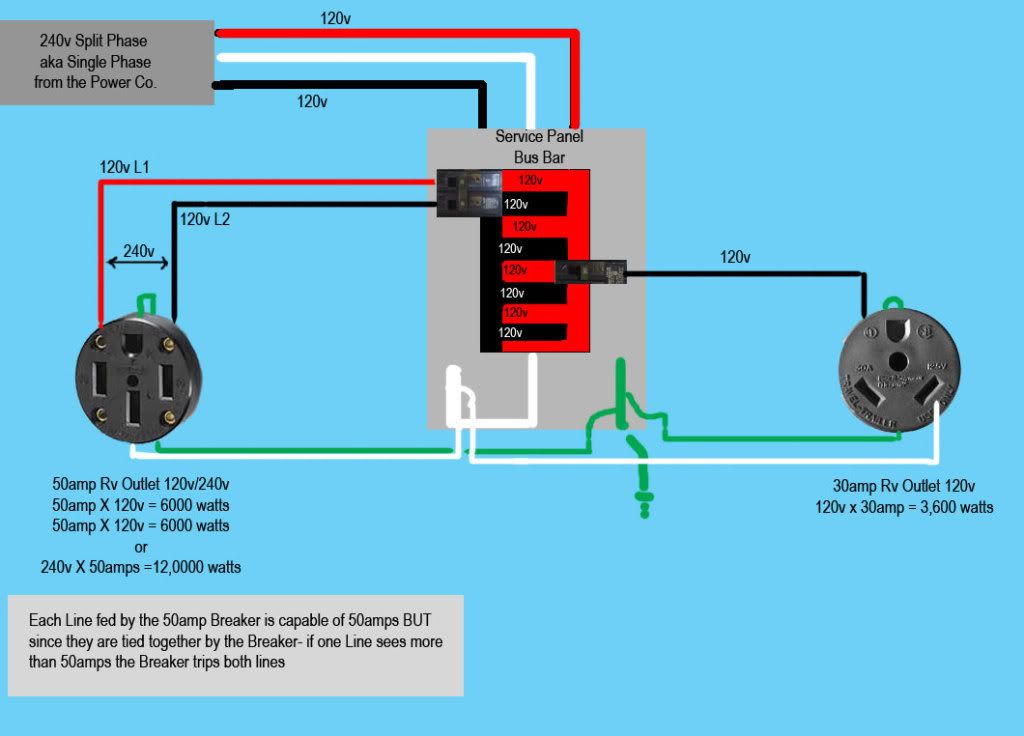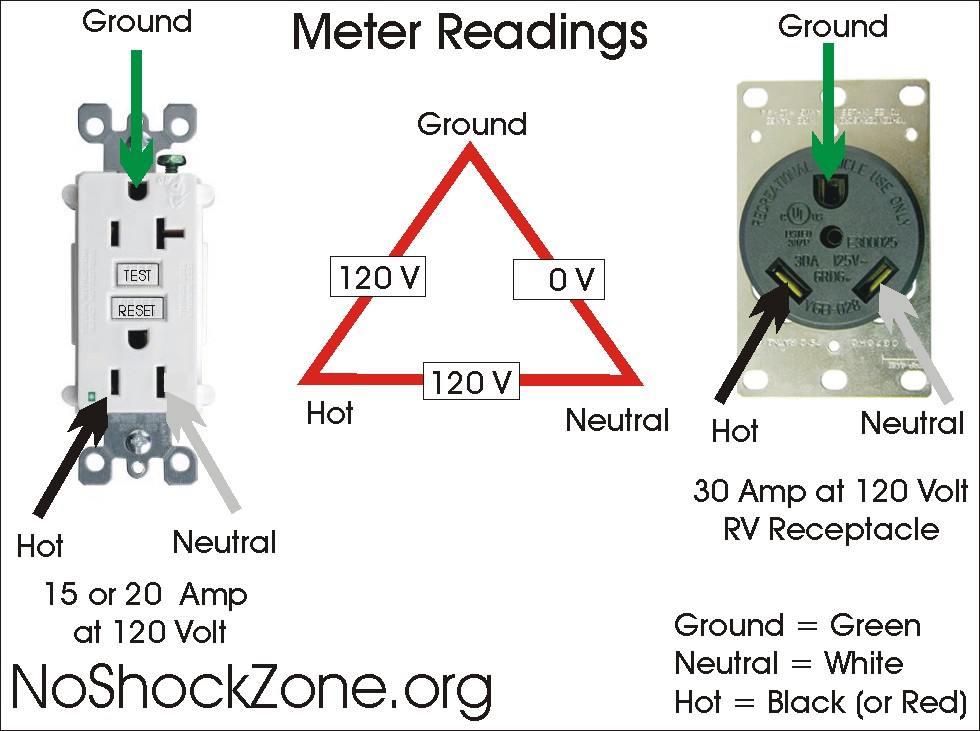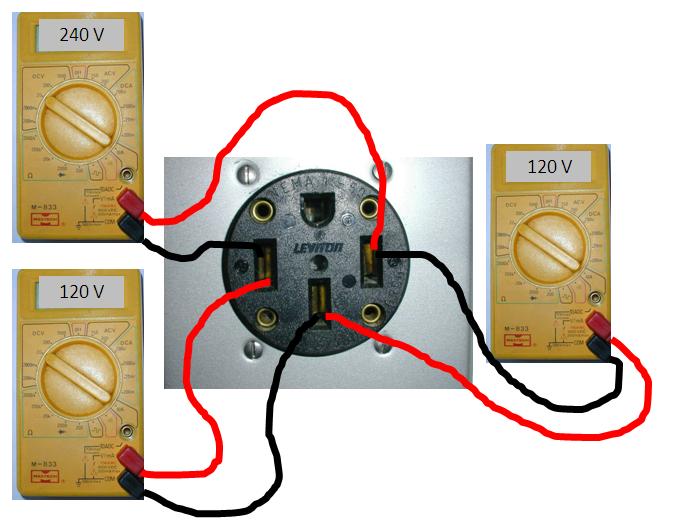Forum Discussion
86 Replies
- 720DeereExplorer
AniJet wrote:
LostinAZ wrote:
What isn't being mentioned when we discuss two 110 V legs is they have to be out of phase to create 220V service. My understanding is that the 50 Amp service we hook into at RV Resort/Park pedestals, the two 110V 50 amp legs are not out of phase and therefore 220V is never present inside the RV.
Not so. If that was the case, the neutral would carry 100 amps if you were able to use all 50 amps on each hot leg. They must be opposite phase. If done correctly, when the load is the same on each hot leg the neutral carries nothing. The neutral only carries the difference between the hot legs. You can plug into any properly wired 220vac outlet as long as the plug and receptacle match (or you have the properly wired adapters).
It's all done in the RV. Each load is wired across only one hot leg and the neutral so the load will only see 110vac. A load would need to be wired across both hot legs to see 220vac.
Edit: It must have a neutral and ground. Any receptacle with no neutral (like a welder plug) should never be used for a RV.
Dumb question.....what if you ran a separate neutral back to the panel for your adapter? - RoyBExplorer IIThis is typical camp ground pedestal connections for both 50A and 30A RV receptacles.
This is what is required to operate the 50A and the 30A RV Trailers connections.
These are the ways to measure the receptacles to insure it is ok to use for the Rv trailers....
RV 50AMP service measurements
RV 15A/20A/30AMP service measurements
Just my thoughts
Roy Ken - Sandy___ShirleyExplorerHere is the picture you want:

Your RV breaker panel is just like your house panel. You have two hot sides, the sides of the outlet plug, and a neutral in the middle. Nothing in the RV is connected to both hot leads, so the 240 v you see in the top left corner should never happens. You just have to double check to make sure that either side to the bottom center is only 120v. If you wire it wrong and one of those 120 v meters is reading 240 v, you will blow up anything you connect to it.
Each side is alternating 120 v current, from plus 120 to minus 120. When you compare that to the center neutral at 0 volts, the difference between the two wires is just that 120 volts plus or minus.
The key to 240 volts is that the two sides are 180 degrees out of phase. When one side is at plus 120 volts the other side is at minus 120 volts, so at their peaks, the differences between the two voltages is 240 volts. You are comparing the two sides to each other, not to the neutral or ground. - ChadHintonExplorerThis is why I installed a Surge Guard (http://trci.net/products/surge-guard/transfer-switches/50a-plus-hardwire-rvc) on my RV. I've seen a few pedestals that didn't look quite right and read too many posts about folks finding out the hard way that something was wired wrong.
- Sandy___ShirleyExplorerThere are only 3 wires in the ground, the covering is not metal
Either way, the point is to double check any new connection for your RV. A mistake can be very costly. - Your pool filter pump does have two hot and a ground.
The thread drifted away from branch circuits and asked about the main utility supply. Connection from the utility transformer is from both ends of the low voltage (240v) coil (hots) and the transformer center tap (neutral). - Sandy___ShirleyExplorer
smkettner wrote:
I am talking about the direct connection from main box to the utility transformer as asked.
You will see three wires come into your main box. Two hot and the neutral.
Earth ground is created at the main panel and bonded to neutral.
Utility transformer may have its own earth ground but I have no real idea.
I’m not sure that “direct connect” means that much. My pool filter pump has a “direct connect” from our panel box to the pump. It is only 3 wires and two are hot to give it 220 volts! I have a hard time believing that the third wire to a pump connected to the swimming pool isn’t ground!
Look, do what you want, it is your RV, just make sure you use a volt meter to check the voltages from each hot leg to neutral. If you don’t know what I mean by that, call an electrician! - Atom_AntExplorerThe house entry is 2 hot and 1 neutral - no ground. Earth ground is created at the house panel and was never really around before the 70s. If you bought a new range or dryer, the neutral was just grounded to the chassis.
- wittmebaExplorer
smkettner wrote:
I am talking about the direct connection from main box to the utility transformer as asked.
You will see three wires come into your main box. Two hot and the neutral.
Earth ground is created at the main panel and bonded to neutral.
Utility transformer may have its own earth ground but I have no real idea.
Isnt it suppose to be two hot and 1 gnd? - I am talking about the direct connection from main box to the utility transformer as asked.
You will see three wires come into your main box. Two hot and the neutral.
Earth ground is created at the main panel and bonded to neutral.
Utility transformer may have its own earth ground but I have no real idea.
About Fifth Wheel Group
19,024 PostsLatest Activity: Aug 13, 2025